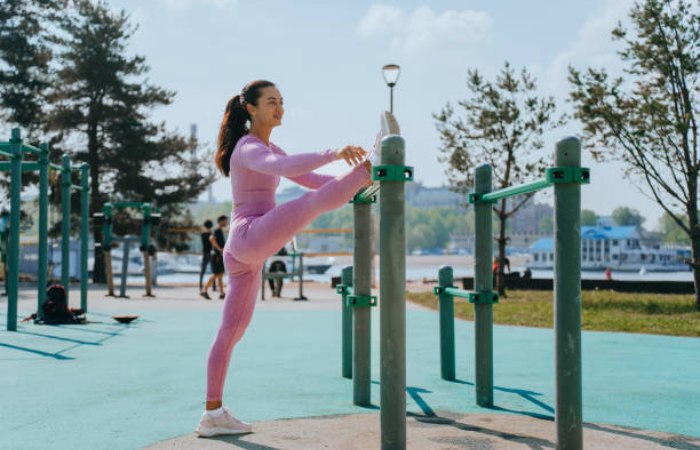Flexibility And Mobility means the ability to bend and stretch your body without experiencing strain or discomfort. Mobility is the ability to move your body freely and without problems.
As we age, our muscles can become less flexible and mobile. This can happen if we don’t move enough, have poor posture, or have a history of injury. When our muscles are tight, everyday tasks like bending or reaching can be more difficult.
Improving flexibility and mobility isn’t just about being able to do fancy stretches. It helps prevent injury by making our muscles more robust and more flexible. It can also improve our standing and sitting posture, reducing back and neck pain. And if you love sports or outdoor activities, being more flexible and mobile will make you a better person.
The Difference Between Flexibility and Mobility
Flexibility refers to the aptitude of a muscle or group of strengths to lengthen through a specific range of motion passively. At the same time, mobility is the ability of a joint to move through a particular range of motion actively. Flexibility has more to do with muscle length, while mobility has more to do with joint movement. Both are important for optimal movement patterns, injury prevention, and overall physical performance.
Also Read: Immune system
Benefits of Flexibility and Mobility

Increasing flexibility and mobility provides many benefits, including:
- Reduced risk of injury: Flexible muscles are less likely to become strained or torn during physical activity, reducing the risk of injury.
- Improved athletic performance: Greater flexibility and mobility can improve actions in sports and other physical activities by permitting a broader range of motion.
- Improved posture: Better flexibility and mobility can help exact postural imbalances, reducing the risk of back and neck pain.
- Improved joint health. Increased flexibility can help maintain healthy joints and prevent arthritis by promoting better joint lubrication and mobility.
- Increased Range of Motion: Better flexibility allows for a more outstanding range of motion in your joints, making everyday movements more efficient.
Reasons for Tightness
Understanding why rigidity occurs can help us solve underlying problems and improve flexibility more effectively. Some common causes of muscle tension include:
- An inactive lifestyle can lead to muscle stiffness and decreased flexibility. Regular physical activity will help maintain muscle flexibility and joint mobility.
- Poor posture can cause muscles to become tight and others to become weak, leading to imbalances in the body.
- When some muscles are more challenging than others, it can lead to tightness and limited range of motion.
- As we age, our muscles lose elasticity, which leads to decreased flexibility.
- Past injuries or injuries can cause scar tissue to form, reducing the flexibility of the affected areas.
How to Self-Test Your Flexibility and Mobility?
To measure your flexibility and mobility, you can take a few simple tests:
- Sit and Reach Test: Sit on the floor with your legs extended and reach forward as far as possible. This test tests the flexibility of the lower back and hamstrings.
- Shoulder Mobility Test: Stand and raise one arm above your head, then place the other behind your back. This test examines shoulder movement.
- Hip flexion test: Get on one knee with the other foot on the floor. Lean forward to feel the stretch in the front of your thighs. This test tests the flexibility of the hip flexors.
Ways to Improve Flexibility and Mobility Without Stretching
- Foam rolling: Foam progressing is a form of self-myofascial issue that helps relieve muscle tension and improve blood flow, which can improve flexibility and mobility.
- Mobility exercises. Mobility exercises focusing on joint movement can help improve the range of motion without traditional stretching.
- Yoga can improve flexibility, mobility, and strength through various poses and movements that lengthen and stretch muscles.
- Dynamic warm-up. Before training, performing dynamic warm-up exercises will help prepare your muscles for movement and improve flexibility.
- Pilates: Pilates focuses on core strength, flexibilitys, and overall body awareness, which can improve mobility without traditional stretching.
- Massage therapy: Regular massage can help decrease muscle tension and improve flexibility by relieving muscle tension.
- Hydration and Nutrition: Drinking fluids and eating a balanced, nutrient-rich diet can support muscle health and flexibility.
Why You Shouldn’t Ignore Incomplete Range of Motion?
Neglecting a limited range of motion can lead to muscle inequities, poor position, and an increased risk of injury. It may also indicate underlying problems such as muscle tension, stiffness, or dysfunction. Addressing a limited range of motion through targeted exercises and mobility work can improve the overall quality of movement and prevent future problems.
Conclusion
Joining these techniques into your daily routine will help you achieve greater flexibilitys, mobilitys, and overall physical health. By understanding the difference between flexibility and mobility, recognizing the benefits of increased flexibilitys, and testing your flexibility and mobility yourself, you can take active steps to improve your range of motion and live a healthier, more active lifestyle.

